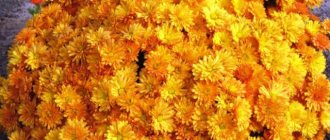The unique flower has about 10,000 varieties. Each species has its own shade, leaf shape, and inflorescence size. China is often considered the birthplace of the flower, then its species began to spread in Europe. In modern times, the natural growth of the flower in nature is observed in India, the Caucasus, Europe and the Middle East.
Indian chrysanthemum is a perennial plant of the Asteraceae family; it can be grown in the garden and indoors. A chrysanthemum growing in a flowerbed reaches a height of about 1.5 meters. The bushes also may not be large; the height of the plant depends on the variety. The stems of the flower have a simple erect structure, the leaves are dissected, the inflorescences reach a diameter of up to 25 cm. The flowers bloom in lush colors, forming a kind of basket. The popular name is “Indian Golden Flower”. The flower seeds ripen by December.
The flowering period mainly falls in the autumn months: September and October. During this period, the chrysanthemum becomes the real queen of the garden plot, since many flowers have faded by this time, and the lush bushes of the Indian wonder continue to delight the eye until frost. Sometimes, during a soft transition from autumn to winter, the flower blooms until December. Even after the first snow, amazing flowers remind of the passing autumn, but unfortunately, they die off in winter.
Popular varieties:
- Aurora is the most popular chrysanthemum variety. The flower blooms in September and October. Aurora is popular for its charming orange inflorescences. The diameter of the flowers reaches up to 10 cm, and the stems up to one meter. The flower is characterized by abundant flowering.
- Carnival. This variety is distinguished by the palette of petals and the design of the flowers; they are double. Flowering is long lasting.
- Primavera. The variety is characterized by flowering from September to October, the flowers reach up to 10 cm in diameter, the predominant shades of the petals are soft pink.
- Like Worth. Very simple flowers, resembling a chamomile in appearance, the petals are flat and orange in color.
- Anastasia. Huge inflorescences reach up to seventeen centimeters in diameter, flower palette: bright yellow, lilac, pink, white, green. The flower is very delicate and sophisticated, blooming for a long time.
- Tsiya. This variety is characterized by low bushes; the flowers have burgundy petals with a white border, leading to a green core.
- Artist. This type of chrysanthemum is characterized by flat inflorescences and double color, the petals have a white and pink tint. This variety blooms for a long time and takes up little space in the flowerbed.
- Vimini. This variety fades very quickly. The flowers look like small sunflowers, with a brown center framed by orange petals.
- Snow elf. This variety blooms exclusively in autumn and is rich in shades of white. The double feature of the flower creates the impression of snow, the diameter of the flowers reaches up to 8 cm, the bushes are of medium height.
Features of Indian chrysanthemum
Indian chrysanthemum is a large-flowered annual or perennial plant. In central Russia, it is not planted in open ground due to some of its features:
- It does not tolerate high temperatures; the optimal temperature for it is considered to be 15-16 °C.
- She doesn't like direct sunlight.
- It needs watering once every 3 days, and during flowering it must be sprayed so that the inflorescences do not dry out.
- For irrigation, you need to use either soft rainwater or tap water that has been standing for 3 days.
Taking into account all its features, Indian chrysanthemum is planted for cutting either in greenhouses or in pots at home. True, in the summer it can be planted in a flowerbed, but only as a container crop.
This chrysanthemum blooms in late autumn with large flowers that form beautifully into a bouquet and lasts a very long time when cut. It is enough to change the water in a timely manner and add granulated sugar to it at the rate of 2 tsp. for 1 liter of water.
Early varieties of Indian chrysanthemum can be grown in open ground, but the flowers of early varieties are small. They begin to bloom in early August.
Botanical characteristics of Indian chrysanthemum
For most people, the very idea of the “queen” of the autumn garden is associated with a large semi-double flower, usually with yellow or white petals. This is exactly what the classic greenhouse Indian chrysanthemum (Chrysanthemum indicum) looks like - a perennial herbaceous plant of the Aster family or, as they are also called Asteraceae.
It is believed that all hybrid varieties popular in floriculture come from Chrysanthemum indicum. Today their varieties number in the tens of thousands. These are small-flowered, including “button” ones, and very large, with inflorescences up to 25 cm or more in diameter.
Indian chrysanthemum (Chrysanthemum indicum)
The ever-growing interest in greenhouse chrysanthemums stems not only from their extensive varietal diversity, but also from the relatively low energy and labor costs that are necessary for their cultivation, which is very important in our difficult, fast times.
Luxurious large-flowered Indian chrysanthemums, those that are sold all year round in cut form, are almost impossible to grow in gardens in the middle zone. These are not just heat-loving plants that do not overwinter in our conditions, they also have special requirements for day length, which are very difficult to fulfill.
The vast majority of types of cut varieties that we today have the opportunity to purchase all year round belong specifically to the Indian group, since they can only be grown in greenhouses or conservatories. Of course, there are exceptions to the rules. Some amateur flower growers manage to grow bouquet and potted varieties, like garden varieties, in open ground on their summer cottages, but only in super-early years and in the most favorable climatic conditions.
What is the name of the green bush chrysanthemum?
The green chrysanthemum flower is quite unusual and new; the variety and all its varieties were obtained by breeders after 2020. They have an interesting color, which can be from emerald to light green. Some species change color depending on the lighting, for example, in bright sun their palette is yellow, and in the shade it is green. In addition to the shade range, they can differ in size and shape; there are single-headed varieties and bush ones. The latter, in turn, are short, medium and tall, as well as large-flowered and small-flowered. To make it clear what shade a particular variety is, the word “green” is usually attached to its name, which means “green”, or “green dark” - “dark green”.
Advice! When planting crops, you should carefully select specimens according to height and variety.
Cultivation of Indian chrysanthemum
Only orchids can compete with the duration of flowering of chrysanthemums. But chrysanthemums bloom at a time when the brightness of the colors is dulled - in the fall. This quality of chrysanthemums attracts attention. Large chrysanthemums were originally called “Indian”, since in those days it was customary to call all plants from the East that way.
Now more than 10 thousand varieties of Indian chrysanthemums have been bred. They have a variety of shapes, colors, and sizes. Amateur flower growers, passionate about this wonderful plant, cultivate Indian chrysanthemums using the method of spring cuttings from mother bushes. They are stored at low temperatures without hypothermia in specially designated places: basements, insulated greenhouses, greenhouses. However, it is very difficult for an amateur to grow gorgeous Indian chrysanthemums with large flowers on his own in the garden. But, if you apply the advice of experienced flower growers, having prepared everything necessary for this, then you will be able to make your dream come true.
Bouquets with red chrysanthemums
Red chrysanthemums look equally impressive both in mono compositions and in combination with many other plants. Mixed bouquets are made up of chrysanthemums with bright gerberas, elegant roses, sophisticated lilies or expressive alstroemerias.
A bouquet collected from large- and small-flowered varieties of different shades of red will look beautiful and unusual. Such a composition can be presented to a manager or colleague on any special occasion, or it can be presented to a dear person as a sign of special respect and recognition.
Red, carmine, burgundy, and wine shades are chosen if they want to convey ardent love and affection. Emphasize the grace and beauty of the recipient. These flowers are used to make monochrome bouquets, or used as an accent in complex compositions.
Bouquets of red chrysanthemums combined with white and yellow roses and carnations will undoubtedly surprise and delight a creative and extraordinary person, and compositions with pink alstroemerias can be an ideal gift for a first date. You can choose a combination of colors and shades for a specific event yourself, guided by your own imagination, or by contacting a competent florist.
Indoor chrysanthemums
Indian chrysanthemum can grow indoors. In order for the chrysanthemum to feel good in the pot, it is necessary to monitor the condition of the soil. It should be loose, not acidic, and consist of garden soil, humus, and sand. For good flowering, home flowers need to be fed with fertilizers twice a month. During the period of leaf blossoming, nitrogen baits are used, and as soon as the flower begins to form buds, potassium-phosphorus baits are used.
The flower pot should be placed in the house so that the air temperature is no more than 15 degrees above zero. The ideal location for it would be north-facing windows. Access to sunlight is required for good flowering.
Instructions for restoring old furniture with your own hands: Review
Growing from seeds
When growing flowers from seeds, you must adhere to some rules:
- Indian chrysanthemum is planted in open ground only as seedlings.
- The seeds are first packed in damp cloth and film.
- Store in the refrigerator at +5 degrees for several days.
- Wet seeds are planted in the soil in rows.
- The soil in the box should always be moist.
- The seeds are slammed into the ground, but not sprinkled, thereby providing access to light.
- Cover the trays or boxes with the planted seeds with film, periodically ventilating them.
- After seed germination, the film is removed and the soil is loosened.
- Seedlings are planted in the ground outdoors after the onset of warm days.
- The distance between bushes should be at least 50 centimeters.
- The soil must be periodically loosened and moistened.
- Flowers must have full access to light.
- After flowering ends, the stems are cut at a height of 10-20 centimeters, placed in boxes with moistened sand.
- Store winter at a temperature of +2 - +5 degrees without irrigation.
Description
This is a fairly large perennial plant. Indian chrysanthemum in the garden grows up to 1.5 meters. It has simple stems and serrate-toothed leaves (dissected). The inflorescence is a basket in which the seeds ripen by December. Active flowering begins in September-November.
Under natural conditions, Indian chrysanthemum is distributed throughout Europe, the Middle East, the Caucasus and India. In open ground, these plants grow only in the southern regions. In terms of flowering duration, only orchids can compare with these magnificent flowers. But one of the advantages of chrysanthemums is the time of flowering - deep autumn, when the brightness of natural colors is already muted. These luxurious flowers attract increased attention from lovers and connoisseurs of natural beauty.
Large chrysanthemums began to be called Indian, since previously all oriental plants were called that way. To date, more than ten thousand varieties of Indian chrysanthemums have been bred. They all differ in the shape of leaves and flowers, color, and size. The large-flowered Indian chrysanthemum is particularly attractive, but is one of the most difficult plants for the novice gardener to grow. True, by applying the advice of experienced flower growers and preparing everything you need, you can grow magnificent flowers that will not only decorate the area, but will also become your pride. There are two methods for growing garden and indoor chrysanthemums.
In the Nikitsky Botanical Garden
Many types of sunny flowers are presented at exhibitions held in this legendary garden in Yalta.
And among the endless variety of shapes and colors, it is impossible not to notice spots of bright red color: this is a red chrysanthemum, bred by the Botanical Garden breeder I. A. Zabelin, under the name “red banner”.
Its buds are small: approximately 10-12 cm in diameter, but their color, turning from bright red to orange-red at the core, is unique. This is one of the old varieties.
But the “autumn motif,” also the result of the work of the Garden’s specialists, already boasts larger buds, which are red balls with a bronze tint about 15 cm.
Another chrysanthemum with the same diameter of inflorescences is called “regalia”. Its color is deep red, and the bud shape is spherical.
You can name several more types of red chrysanthemum, such as “torch”, Spira Red and “adonis”, also created by I. A. Zabelin, as well as the recently bred variety “Zoryanochka” and the honey-bearing species “bee”.
The impact of the color red on the human psyche cannot be overestimated: it gives vigor, gives energy, joy and a great mood.
Popular varieties
Among the variety of types of Indian chrysanthemums, there are both popular ones, leaders, and outsiders. This positioning is caused by various reasons - ease of cultivation, availability of seed, or external characteristics of the flowers. In addition, the popularity is due to the connection with the probable regions of growth of chrysanthemum varieties.
Aurora
The variety is characterized by flat large inflorescences, the petals are orange in color. The diameter of a chrysanthemum flower is about 100 millimeters. The growing season extends throughout almost the entire autumn – from September to October. The height of the Aurora stem is average - up to 1 meter.
Anastasia
The Anastasia variety pleases gardeners with a wide variety of colors - white, pink, green, lemon, even lilac. It remains to add to this description the gigantic size of the inflorescence - up to 20 centimeters. The disadvantage of chrysanthemum can be considered the fragility of the basket.
Artist
This species is recommended for indoor breeding; it is compact and harmonious in development. It blooms for a long time, the petals are originally colored white or pink, with 2 stripes on each petal.
Vimini
Vimini is compared to a little sun: a bush up to 30 centimeters high, multi-colored, brightly colored petals. The color of chrysanthemum petals smoothly changes from brown (in the center) to orange, sometimes lemon or yellow.
Gazelle
A chrysanthemum variety with a strong stem, suitable for creating compositions or bouquets. The main distinguishing feature of the Gazelle is its bright white flowers, almost 20 centimeters in size.
Valentina Tereshkova
The variety, dedicated to the first female cosmonaut, will decorate the flowerbed with its presence and looks great when planted alone. The inflorescences are large, painted in dark shades of crimson. The bottom of the chrysanthemum petals is slightly lighter than the top.
Aviator
The Aviator variety is recently known and is classified as semi-double. Bred in the Netherlands. The inflorescences cannot be called large; they are up to 8 centimeters. Petals are four-row, straight. Chrysanthemum easily tolerates transportation, especially when cut. The bush is shrouded in bright emerald leaves and is classified as an upright plant.
Alomos
A special Dutch type of chrysanthemum, suitable for cutting and transportation. The inflorescence, at first glance, is simple, reminiscent of a chamomile. Basket up to 7 centimeters in diameter. The petals are wide, painted in lilac or burgundy tones. At the end they turn white. The height of the bush is average - up to 700 millimeters.
Barolo
Chrysanthemum of Italian selection. The height of the bush is about 60 centimeters, the diameter of the inflorescence is up to 7. The petals are regular in shape, bright red in color, with an even distribution of color over the area. The center of the basket is yellow, with light greenery. The leaves have a smooth surface, feathery, herbaceous color. Cut flowers can last in a vase for up to 20 days.
Bartoli
The Dutch species Bartoli produces double inflorescences of orange color. The size of the basket is from 5 to 7 centimeters. The bush is upright, about 700 millimeters high, with almost no branching. The leaves are bright green and pinnate. Cut chrysanthemum flowers last a long time and are transported.
Barça
A variety with large double flowers (up to 10 centimeters in diameter). Color - dark purple or dark purple. Chrysanthemum bush of medium height - up to 700 millimeters.
Glossy
Bush hybrid of Dutch selection. The size of the basket is small, up to 7 centimeters, and is distinguished by white-lilac petals. Outwardly it resembles a chamomile, in the center there is a green chrysanthemum. Cut flowers remain unchanged for up to 20 days and emit a light tart aroma.
Grandeza
The Grandez species is distinguished by its miniature size and is suitable for growing in an apartment or in a pot. Petals are semi-double, multi-row, mixed colors. The bushes are small, compact, up to 40 centimeters in height. The size of the chrysanthemum inflorescence is about 7 centimeters.
Dante
The Dante variety is distinguished by delicate double inflorescences of a lilac hue, up to 7 centimeters in diameter. The leaves on the bush are brightly colored and green. After being cut from the bush, chrysanthemum flowers are stored for a long time and are used to make bouquets.
Carnival
The species is an early-growing species; beautiful multi-colored “daisies” bloom on a bush 40-60 centimeters high, dotted with medium-sized (7-centimeter) inflorescences. The range of colors ranges from pink to purple. The petals are white below.
Robineau
The flowers are unusually colored: there is a mixture of yellow and burgundy, pink or red and white. Chrysanthemum petals are slightly curled at the base and their growth pattern resembles that of a chamomile. Bushes of medium height.
Red Start
Upright bushes of medium height (up to 70 centimeters) native to the Netherlands develop velvety-textured, purple baskets. The diameter of the inflorescence is up to 7 centimeters. The foliage is medium dense, bright green. Plants are grown for cutting.
Royce Lovely
The Royce Lovely variety has bright pinkish-lilac terry baskets, with slightly dark petals in the center. The stem is straight, dotted with deep green leaves. Cut chrysanthemums are not afraid of transportation and are stored in bouquets for a long time.
Fanfare color mix
The bushes of this variety are of medium height, with inflorescences of semi-double texture. Plants can be grown outdoors, in an apartment. The size of the baskets is up to 6 centimeters, with the height of the bushes up to 60. The petals are colored white, pink, red, yellow or orange.
Fianna
Fianna is distinguished by a tart herbal aroma and greenish-colored petals. Bushes - up to 70 centimeters, small inflorescences, about 8 centimeters in diameter. The leaves are separate and pinnate. Chrysanthemum is grown for cut flowers.
Jaguar Purple
The Jaguar Purple variety is not gigantic in size and allows the cultivation of baskets up to 10 centimeters. The average size of inflorescences is 6-7 centimeters. The bush is straight, with light branching. The color of the petals is bright purple.
Indicum
This is the general name for all varieties of Indian chrysanthemums. Considering that the genus is numerous, rich in varieties and hybrids, among the variety of shapes and colors you can find both indoor and outdoor plants with large baskets.
The best varieties of winter-hardy chrysanthemums: reviews from gardeners
Alla Viktorovna, Moscow region
For growing in the countryside, I prefer perennial flowers. I like chrysanthemums because they bloom for a long time. I tried growing several varieties. The best winter-hardy chrysanthemum varieties for the Moscow region, in my opinion, are Flamingo and Aurora. Flamingo captivated me with the compactness of its bushes.
Very small, no higher than 40 cm with white and pink flowers. Blooms until October. It retains its rich color almost throughout the entire flowering period. Aurora is the complete opposite. The bushes are very tall - up to 1 meter with bright flowers. I grow each variety separately from each other. A selection of beautiful yellow flowers with photos
Veronika Andreevna, Sverdlovsk region
The “Stranger” chrysanthemum begins to bloom early, which is good for areas with a climate like ours.
I like this variety for its modesty and at the same time grace: a moderate amount of foliage, creamy inflorescences and strong peduncles. The flowers have a distinct aroma. Sometimes I cut a few flowers for the house. They stand for several weeks in a row without losing their decorative effect. A good winter-hardy chrysanthemum variety. Tatyana Sergeevna, Novosibirsk region
To decorate the garden, I chose “Lipstick” and “Stars of the Galaxy” chrysanthemums. Both varieties winter well. The first variety is represented by low bushes with rich red flowers. I place them along the paths in the garden. The stars of the Galaxy are represented by medium and large flowers of different colors. This is an ideal option for open ground. The landings are luxurious. There is no other way to say it. They really create an imitation of a carpet, as stated in the description.
Korean and Indian chrysanthemums - video
Care
Regardless of the chosen growing method, the future queen of the flower garden must be provided with decent conditions, daily care and attention. This includes regular but not excessive watering, fertilizing, pruning and replanting. In addition, the growth of a chrysanthemum bush is influenced by the ratio of temperature and humidity and soil composition. To form a harmonious shape and ensure sustainable flowering, gardeners use pinching.
Raspberry Moscow giant (Moscow giant): characteristics and description of the variety, cultivation
Watering
Chrysanthemum needs a constant humidity of 75%. Before flowering, this figure can be reduced to 65-60%. Therefore, watering should be regular, but not excessive. The optimal frequency is up to 2 times a week. Flooded plants have a tendency to rot.
Top dressing
Minerals for Indian goldenflower are an important addition to the “diet”. The first phase of fertilizing includes the application of fertilizers before planting; organic matter (humus) is suitable for this. The further procedure is divided into several interconnected stages:
- Leaf growth. At this time, the plant needs nitrogen and its compounds (use of mineral complexes).
- Formation of inflorescences. Chrysanthemum needs phosphorus and potassium.
Do not forget that exceeding the concentration of fertilizers in the soil will lead to inhibition of flowering. Therefore, before use, be sure to study in detail the recommendations for preparing and adding solutions of mineral complexes.
Trimming
Pruning begins when the flowering of chrysanthemums is completed. Traditionally, the top of the plant is removed completely in order to later remove the rhizome from the ground along with the lump. The remaining part must be moved to a cool, dark place (cellar, basement). There the plant will be stored until spring; it will have to be moistened occasionally.
Transfer
Conventionally, replanting can be considered the annual digging of a chrysanthemum in the fall, since in the spring it will be planted in a new place (or an old one, but again). It is recommended to periodically move the plant around the flowerbed to avoid soil depletion. When transplanting, try to carefully remove the earthen lump so as not to damage the roots located close to the surface. After planting, the plant is immediately watered and fertilized.
Wintering
For wintering there are 2 options: in the ground or in a pot. In the first case, the chrysanthemum is cut and covered, protecting it from the cold. In the second, they are transferred to the basement for the winter.
Landing
Experienced gardeners recommend planting flowers in rainy weather or a cloudy, not sunny day. If this condition cannot be met, then early morning or late evening is chosen for the procedure.
Pre-dug holes up to 40 centimeters deep are generously filled with settled water. Then drainage, a soil conglomerate composed of soil and a vermicompost mixture (20 to 1), is laid at the bottom. The seedling (cutting) is installed vertically, sometimes fixed on an additional support (tall species).
Selecting a location
The genus of chrysanthemums belongs to sun-loving plants; shadow is evil for them. The same applies to moisture. It is advisable to plant bushes on a hill. Since the root system is shallow, the soil should not be allowed to dry out.
Soil requirements
Soil with sufficient air and moisture permeability is considered optimal for chrysanthemums. The content of minerals necessary for the plant will also not hurt. Poor, overly dense soils are fertilized with peat, humus or compost. It is allowed to add drainage substrate and coarse sand. The acid composition requirements are as follows: neutral or weak reaction.
Deadlines
It is better to plant flowers in the spring, when warm, dry weather without night frosts sets in. May is suitable for this; you can shift the planting date to the beginning of June. It was not possible to plant the chrysanthemum in the spring; this is done in the fall, until approximately September 15th. This period is important, because then frosts begin on the ground.
If this condition cannot be met, then the seedlings are rooted in pots by performing low pruning. Next, the container with the flower is placed in a warm, dark place. During the winter season, the soil is kept moist, so the seedling will have a better chance of gaining strength and growing.
Preparation of planting material
Since chrysanthemum does not inherit the characteristics of the variety when propagated by seeds, the following are among the most common planting methods:
- By cuttings.
- Saplings.
- Dividing the bush.
Of course, healthy, strong plants, without traces of disease or pest damage, are used as planting material. When cuttings, shoots are cut into pieces no more than 20 centimeters in length. Rooting occurs approximately 30 days after planting the cuttings. It is produced in boxes filled with a soil mixture (part earth, 2 parts sand and part humus). In spring, strengthened seedlings are transferred to open areas.
When grown from seeds, chrysanthemum will bloom in 2 years, not earlier.
Open ground planting scheme
Cuttings, immediately planted in open ground, are placed one from the other at a distance of up to half a meter. Close proximity will prevent seedlings from developing harmoniously, growing and receiving sufficient amounts of minerals from the soil. It is necessary to provide support, this is especially important for tall varieties. The plantings are covered with film to provide the seedlings with favorable conditions.
Flower propagation
There are three ways to share flowers with friends:
- Cuttings
- By division during transplantation
- seeds.
Let's look at each method in more detail.
Cuttings
The most common way. To do this, select cuttings up to 10 cm high. The upper leaves are left and the entire length is removed. The resulting workpiece is placed in water or a peat mixture. As soon as roots 30-40 cm long appear, they can be transplanted into pots using the technology described above.
If you choose the option of rooting in peat, then you can build an artificial greenhouse over the green shoot. A plastic bag is suitable for this. Don't forget to remove it every day for ventilation.
By division during transplantation
You need to divide the bushes during replanting after winter. Carefully dig up the bush and shake off excess soil from the roots.
At the same time, prepare the instrument for circumcision and pour boiling water over it. Divide the bush so that each section has a few stems and quality roots. To prevent chrysanthemums from getting sick, treat the cuts with charcoal.
Propagation by seeds
Propagation by seeds is the most troublesome, but at the same time it is amazing to watch how a green seedling emerges from a tiny seed. Seeds are planted in small shallow containers.
The soil should consist of peat and humus. And it’s better to scald even store-bought soil or heat it to 130 C to avoid diseases. And chrysanthemums can get sick. They can get sick with powdery mildew, septoria and gray rot.
The seeds are slightly deepened at the surface, often sprayed and covered with film. In order for a beautiful and long-awaited flower to grow from a seed, you need to make a lot of effort:
- keep the temperature at 23-25 s
- ventilate under film
- moisturize and water regularly
After 2 weeks, the first shoots appear; immediately place them in a lighted place. Continue covering with film, but increase the ventilation time. So to speak, harden yourself to new conditions. 2-4 large leaves are a clear sign that the plants are ready for individual cups.
The main thing is to carefully dig out and plant without touching the young root system.
Planting Indian chrysanthemum seedlings in open ground
Young seedlings are afraid of frost, so they are planted in the ground after the onset of warm weather. The distance between the bushes is 50 cm. Flowers prefer loose soil and abundant watering, but they begin to get sick if the soil is poorly drained and the soil is acidified.
For the winter, the bushes are dug up, the stems are cut off at a height of 20 cm, placed in boxes, and covered with damp sand. Keep in the cellar at a temperature of +2 o C without watering. Chrysanthemum grows well in the house; it is one of the few crops that can tolerate the dry air of an apartment. Indian chrysanthemum seeds are planted in the ground in May according to a pattern of 15 cm by 30 cm.
Changeable appearance
Speaking about the bizarre types of sunny flowers, the dune chrysanthemum should also be mentioned. This capricious beauty with a changing character: before opening, the buds have a crimson color, so you are confident in expecting flowers of the same color. However, do not rush: the blossoming “dune” may surprise you with its light yellow or brick-orange color. Like all beauties, she is prone to change. The height of this Korean bush variety is no more than 50 cm, and the width is about 35 cm.
Thus, the plant resembles a ball. “Dune” is popular among landscape designers and florists because it is “friendly” with many other colors and looks elegant in any combination.
Diseases and pests
Unfortunately, the plant is subject to attacks by garden pests, and can also become the target of diseases and viruses.
Chrysanthemum nematode
A worm whose presence is characterized by the appearance of rapidly darkening pale yellow spots. The best control method is to carefully remove in the fall the remains of weeds and foliage, in which nematodes can hide.
Spider mite
Ticks love the juice of chrysanthemums, gradually leading the plant to exhaustion. Their presence is indicated by whitish threads and drying of leaves. The easiest way to get rid of the pest is to spray the flower with water.
Aphid
Small bugs multiply quickly and are capable of destroying large plantations of horticultural crops in a short time. To eliminate the threat, traditional methods, chemistry, and loosening of plantings are used.
Powdery mildew
Overwatering of plants leads to the development of powdery mildew. The best prevention is to follow the planting pattern (at least 40 centimeters between neighboring bushes), pinching, and ensuring optimal humidity.
Pruning Indian chrysanthemum
To form a bush and provoke the growth of lateral shoots, pruning is carried out. To do this, the top of the shoot is cut off 2-3 times. Pinching is stopped about two weeks before the buds bloom. The bush should also be pruned when you are planning to move the flower for winter storage in a cool, dry place. It is necessary to cut off the shoots, leaving only a stem 10 cm high.
Cassandra Pink
Adult chrysanthemum bushes of the Korean variety Cassandra Pink reach a height of 100 cm and are perfect for planting in mixborders and flower beds, as well as for cutting bunches. Lush hemispherical inflorescences of a lilac hue reach an average diameter of 10 cm and delight with their appearance in August-September.
In the case of Korean chrysanthemums, plant height and flower size depend on farming practices. When a round bush with many shoots is formed, the inflorescences will be small - 5-7 cm. If you need to grow large flowers, you should remove the side shoots, leaving 2-3 buds on each stem. Thus, the plant will not waste energy on branching, but will direct all its potential to the development of existing flowers.
The soil for planting plants of this variety, like most chrysanthemums, needs light, nutritious, and moisture-permeable. The soil reaction should be neutral or slightly acidic. It is better to choose a sunny place for planting, protected from drafts.
Beneficial features
There are varieties of chrysanthemums that are endowed with beneficial medicinal properties. And some species of this flower are eaten. Medicinal raw materials are obtained from chrysanthemum petals collected during intensive flowering. They contain: glycoside, essential oils, vitamin A, camphor, adenine, choline. It also contains eufualakone, which is the basis of chamazulene. Flowers should be brewed as a medicine. Thanks to essential oils, there is a positive effect on the subcortex of the brain. In addition, this tea can increase appetite. The infusion is considered effective for Parkinson's disease. Flower tea made in a water bath can quickly relieve fever and fever.











